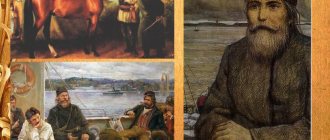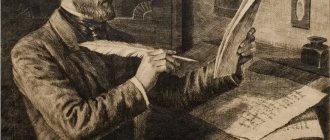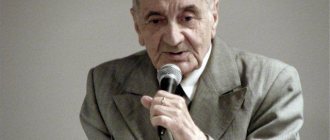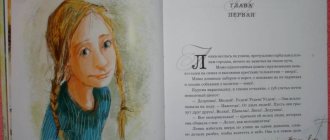Main characters
Vladimir Bogomolov's story "Ivan" was published in 1958. Thanks to the realistic description of events, the work immediately attracted the attention of readers. The main characters of the story are:
- Ivan Bondarev is an eleven-year-old boy, an orphan, who is distinguished by his strong character and willpower;
- Galtsev is a young man, a senior lieutenant, who has become very attached to the teenager;
- Kholin is an intelligence officer, a captain with a sense of humor;
- Lieutenant Colonel Gryaznov - the staff officer with whom Ivan worked;
- Kasatonov is the foreman of the reconnaissance company, the boy’s friend.
The main character is a child who matured early and has suffered the loss of loved ones. He is distinguished by courage and prudence. He is ready, like adults, to carry out dangerous combat missions and risk his life.
The appearance of a boy
Senior Lieutenant Galtsev, acting deputy battalion commander, was woken up late at night. On the banks of the Dnieper, the sentries detained a boy who insists that he be reported to headquarters and gives his name - Ivan Bondarev .
Nobody takes his words seriously, but the boy names several names. Then Galtsev reports the detained teenager to Lieutenant Colonel Gryaznov. The officer orders to take care of the boy and not tell anyone about his appearance.
By order of the senior officer, Galtsev gives the boy paper and pen. The senior lieutenant watches as Ivan takes grains and spruce needles out of his pocket, lays them out on the table, counts them and writes the data on paper.
Galtsev goes to the river. Sitting on the shore, he reflects on how the boy was able to swim to the other side. This was beyond the power of even an adult, well-trained person.
Kholin arrives at the location. He is glad to see Ivan. The boy tells how he had to swim across the river on a log, because because of the Nazis he could not get to the abandoned boat. Kholin handed the teenager a brand new military uniform, which bore the medal “For Courage” and the Order of the Patriotic War. After lunch, the staff officer picked up the boy and they left.
Summary
Chapter 1
Senior Lieutenant Galtsev, who was temporarily acting as battalion commander, was woken up in the middle of the night. A boy was detained near the shore and demanded to be taken to the headquarters to see the commander.
Galtsev saw in front of him a thin boy of about eleven years old, “blue from the cold and shivering.” To the lieutenant’s strict questions, he only answered that his last name was Bondarev, and insistently demanded to be informed of his arrival at headquarters. Galtsev refused to do this, and only when the boy named the names of the staff officers did he believe him.
Lieutenant Colonel Gryaznov confirmed: “This is our guy.” The boy took out “grains of wheat and rye, sunflower seeds and pine needles” from his scarf, carefully counted them and wrote down the data on a piece of paper, which he urgently sent to headquarters.
Chapter 2
Ivan could not fall asleep, and all the time he asked Galtsev whether his message had been delivered or not. Soon a “tall, dark-haired handsome man” Kholin appeared, who greeted Ivan like an old friend. The boy told him that because of the Germans he could not get to the boat, and was forced to swim across the Dnieper from another village. It was a great miracle that “on a stormy night, in cold October water,” he was able to cross the river.
Kholin brought clean clothes to Ivan. When the boy changed clothes, Galtsev noticed that the tunic was “with the Order of the Patriotic War, a brand new medal “For Courage”.” Having refreshed themselves, Ivan and Kholin left by car.
Chapter 3
Three days later, Petty Officer Katasonov came to Galtsev and asked to “see the German” from an observation post. He said that by order of the commander, Vanyushka was sent to “school, to Suvorov,” but he refused. The boy, whose soul was corroded by a terrible hatred of the invaders, wanted to fight the entire war as a scout.
Galtsev went on a detour, accompanied by Kholin, who repulsed him with his unceremoniousness. They went into the battalion first-aid post, where a new paramedic arrived - “a stately, about twenty, beautiful blonde with bright blue eyes.” Noticing Galtsev’s interest in the girl, Kholin began to offend him in every possible way.
Chapter 4
Vanya arrived, looking “refreshed and healthier.” He surprised Galtsev with his talkativeness and friendliness. This time, Katasonov and Kholin were supposed to “transport the boy across the Dnieper to the rear of the Germans.” However, Ivan didn’t even think about worrying - he gnawed on candy and looked at magazines. He really liked Galtsev’s knife, but he could not give it to the boy, since it was a memory of a friend.
From Katasonov, Galtsev learned that Vanya’s father, a border guard, died on the very first day of the war. His tiny sister was killed right in the boy’s arms, and he knew nothing about the fate of his mother.
Galtsev wanted to join the scouts, but Kholin refused him. When it became known that Katasonov was urgently summoned by the Division commander, Galtsev took his place. None of them knew yet that Katasonov had been killed.
Chapter 5
After dinner, Kholin laid out the map and brought Galtsev up to date. After careful preparation, they set out to perform the operation.
Chapter 6
Having safely crossed the river, the scouts hid the boat. Vanya, deliberately dressed in old rags, left his senior comrades and disappeared into the darkness.
Chapter 7
Having released the boy, Kholin and Galtsev hid in ambush. Soon the Germans passed dangerously close to them. Galtsev had a “need, a need to kill them immediately,” and only thanks to the cool and restrained Kholin did he not reveal their presence. When the Germans left, the scouts returned to their own.
Kholin said that Ivan “needs to walk more than fifty kilometers,” and at every step he could stumble upon a German patrol. He was very worried about the fate of the boy, who, in case of danger, no one could come to the rescue.
Chapter 8
Galtsev ordered from a local skilled mechanic exactly the same Finnish machine that Vanya liked. At the right opportunity, he wanted to hand over the knife, if not to the boy himself, then at least to Lieutenant Colonel Gryaznov. Soon such an opportunity presented itself to him. He learned from the lieutenant colonel that Ivan returned from the mission alive and unharmed. Afterwards the boy was sent to study at school, but he left without permission. Galtsev asked to give Vanya the Finn, to which Gryaznov replied that he “has about a dozen of these knives, no less.” The lieutenant colonel did not want to go into details about the little intelligence officer - “the less they talk about them and the fewer people know about them, the longer they live.”
Chapter 9
The severe wound led to Galtsev “becoming ‘limitedly fit’” and sent to Berlin “to seize German archives and documents.” Among the miraculously preserved documents, Galtsev discovered a photo of Vanya. The report said that a schoolboy was detained for “observing the movement of trains” in the restricted area. During arrest, he fiercely resisted, and after interrogation he was shot.
New meeting with the scout
A new sergeant-major named Katasonov appeared in the battalion. He was a modest, quiet, observant middle-aged man. He could sit at observation posts for days and watch the enemy’s movements through a stereo telescope.
The enemy position, located on the opposite bank of the Dnieper, constantly fired at Soviet positions. Kholin arrives again and needs to be given any assistance. Ivan arrives with him. The boy is in a good mood, he is cheerful and talkative . At night he will have to cross behind enemy lines. He doesn't seem to be worried at all. Ivan reads, chews candy and jokes with the soldiers. The teenager's attention is attracted by Galtsev's Finnish knife. This is a memory of a fallen comrade, so the lieutenant cannot give it to the boy.
Sitting near the fire, the teenager told his story. As it turned out, his real name is Ivan Buslov. He was born in Gomel. His father and younger sister died at the beginning of the war, and his mother went missing. The boy had to go through a lot. He wandered for a long time, then fought in a partisan detachment, and visited the death camp in Trostyanitsa.
After the war, at the insistence of Gryaznov, Ivan was going to enter the Suvorov Military School. But now he must think about how to complete the combat mission and take revenge on the enemy. He always managed to get out of difficult situations. The boy could complete tasks that were beyond the power of an experienced adult intelligence officer.
The foreman became attached to the young scout. Katasonych decided that after the end of the war he would definitely adopt him. From Kholin the boy learns that Katalosonov has been summoned to the division. The teenager is offended that he didn’t come to say goodbye. In fact, they hid from Ivan that the foreman was killed.
Now instead of him, Galtsev will go on reconnaissance with him and Kholin.
Having crossed the river by boat, they hide. The scouts must cover the boy, who will have to travel about 50 kilometers behind enemy lines. After making sure that everything is going according to plan, the scouts return back.
Memory of a friend
The senior lieutenant often remembers Ivan and looks forward to meeting him. He managed to get the same Finnish woman for the boy. After some time, he meets with Lieutenant Colonel Gryaznov, who probably knows something about the fate of the teenager. He asks me to give him a gift. It turned out that after returning from the mission, the command decided to send the guy to school. This did not suit Ivan, and he left the division without permission. Galtsev noticed that the lieutenant colonel was reluctant to talk about him.
Shortly before the end of the war, the senior lieutenant ended up in Berlin. Further events described in the work are as follows:
- Galtsev was approved as battalion commander;
- Kholin died in battle, covering the retreat of the scouts;
- Lieutenant Colonel Gryaznov was transferred to a new duty station.
During one operation, Galtsev’s fighters discovered an archive in a German car. In one of the folders, the lieutenant found the file of the young intelligence officer Ivan.
It turned out that during one of the operations the boy was detained. He was tortured for a long time and then shot. The teenager, like many children, gave his life for the liberation of his homeland.
A summary of Vladimir Bogomolov’s story “Ivan” can be written down in a reader’s diary or used to prepare for a lesson . After reading the retelling, the story must be read in its entirety chapter by chapter. The book will not leave the reader indifferent. It allows you to experience the terrible events of the Great Patriotic War, feel the tragedy and realize the severity of the trials that befell the little fighters.
“Around Bulgakov”: “Ivan Vasilyevich” - play, film and history
The figure of Ivan the Terrible appeared in the play “Bliss.” Before going to the future, engineer Rain turns on his time machine, and his room is connected to the king's chambers. the original version the characters of the play see not Ivan IV, but Nicholas I. In the final version, Ivan appears, runs into the room and hides in the attic, where Rain locks him and releases him only after returning from the future. This is not stated directly in the text, but it can be assumed that the “butterfly effect” was at work here: a short stay in the 20th century completely upset the king’s nerves and, upon returning, he began to chop off the heads of his subjects in vain.
The staff of the Satire Theater did not like the play, but the image of the tsar who found himself in modern Moscow aroused genuine enthusiasm. Bulgakov himself reacted to this plot without much enthusiasm, but gradually got involved in the work and actually wrote a brilliant play.
“Around Bulgakov”: a brief history of “Bliss”
©
klin-demianovo.ru / Go to photobank
In 1935, the Satire Theater began work on the play “Ivan Vasilyevich,” but after a dress rehearsal, which took place in the spring of 1936 in the presence of party leaders of the USSR, the production was closed and the play was banned. It was published only in 1965 and only later caught the eye of Gaidai.
In Bulgakov's play the action takes place in the 1920s-1930s, in Gaidai's film it is moved to the 1970s. Accordingly, differences between the film and the play are visible here, and funny anachronisms also arise.
Scene
In Bulgakov's play the action takes place in a communal apartment. This is another reincarnation of the “bad apartment” on Sadovaya, 10. In the early version of “Bliss” this address is even named. Accordingly, Shpak (Mikhelson in Bliss) lives in the next room, and Miloslavsky enters him from the common corridor. It is not clear from the context of the play, but one gets the impression that Bunsha’s house manager lives in the same apartment. In any case, he hung a radio “plate” in the common corridor, which distracts Nikolai (Alexander in the film) Timofeev from work.
In Gaidai's film, the action takes place in a modern house with separate apartments. Specifically, this is the “accordion house” - No. 13 (building 1) on Novokuznetskaya Street (it can be seen from the windows of the Ukraina.ru editorial office), built in 1971. The view from the balcony (the famous phrase about “lepota”) is a panorama of the Moscow River and the beginning of Kutuzovsky Prospekt, taken from building 26 on Novy Arbat, built in the second half of the 1960s (it is also visible from the windows of our editorial office).
This point evokes an anachronism associated with the role of the house manager.
In a building with communal apartments, the house manager was a king and a god, who had the right to register residents and, as a rule, had an intimate relationship with law enforcement agencies.
In a state house with separate apartments, house managers were retained at first by inertia, but they no longer had any special power. In the 1980s, they met almost exclusively in cooperative houses and were, in fact, their chairmen. Such characters still exist today. Accordingly, Bunshi’s intention to establish JAKTs, reflected in the play, disappeared from the film - they no longer existed at the time of filming.
In general, the images of Varvara Plyushch from “The Diamond Arm” and Ivan Bushnya from “Ivan Vasilyevich” are exaggerated - we don’t know whether under the influence of Bulgakov’s work or the memories of Gaidai himself.
Time of action
Bulgakov also recorded a clear time frame for the medieval part of the play - 1571. It was then that Ivan the Terrible's wife was Marfa Sobakina , who died shortly after the wedding.
This dating, however, creates confusion in other significant episodes.
For example, the Tatar prince Edigei died long before the events described and, accordingly, could not ask for an appointment with the king.
On the other hand, the Swedish envoy in 1571 could not be particularly interested in the Kem volost, beloved by the people. The Livonian War was in full swing, Russian troops achieved great success in the Baltic states, capturing the entire coast between Riga and Tallinn (Revel) by 1576. The Swedes destroyed the Kem volost in 1590.
“Around Bulgakov”: in the role of Jules Verne
But unrest on the Izyum Highway did take place: in 1571, the Crimean Khan Devlet-Girey approached Moscow. He did not take the city, but due to strong winds, the fire from the suburbs set on fire by the Tatars quickly spread, and Moscow burned completely. Judging by the chronicles, it was the worst fire in the 16th century. Only the Kremlin survived, for which thanks should be given to Ivan the Terrible’s grandfather, Ivan the Great . He ordered the demolition of buildings along the banks of Moscow and Neglinnaya opposite the Kremlin and planting gardens there (the current Sadovnicheskaya embankment).
Time Machine
In the play "Bliss" there is a time machine, and it is small - time travelers take it with them. It is controlled by a key with a code (it is stolen by Miloslavsky, and that is why the “expedition” is delayed in the future for several days).
In the play “Ivan Vasilyevich” there is no time machine - Timofeev assembles a radio receiver for Bunsha (“It will receive Australia!”). The time machine (quite voluminous) appears only when Timofeev falls asleep. It is also controlled by a key, but without a code—a locksmith makes it for Timofeev.
There is a time machine in the film from the very beginning; it begins to work in a dream (in fact, the machines in the final versions of plays also begin to work in dreams). It is no longer electromechanical, but electronic, and Shurik runs to the “Radio Products” store on Novokuznetskaya.
By the way, its model was made by wood sculptor and cartoonist Vladislav Pochechuev , who was paid for the work with the appropriate wording: for making a time machine.
By the way, in the play Timofeev falls asleep from fatigue, but in the film he is shocked and loses consciousness.
Music
In the play “Ivan Vasilyevich,” before falling asleep, Timofeev listens on the radio to the opera “The Woman of Pskov” by Nikolai Rimsky-Korsakov - which, in fact, gives him a dream about Ivan the Terrible.
In the film, Shurik also sees a film about Ivan the Terrible on TV. We have not yet been able to identify it, perhaps it is “The Tsar’s Bride” by Vladimir Gorikker (a film adaptation of Rimsky-Korsakov’s opera of the same name), but it seems there are no scenes in the Moscow Kremlin. The effect is the same as in the play.
The song “And not a strong cloud has faded away...”, which was sung by the guslars in the film, is a monument of Russian literature. It is called “The Song about the Invasion of the Crimean Tatars into Rus' in 1572” (by the way, a year later after the events described in the play and film) and was written at the end of the 16th - beginning of the 17th century after the Battle of Molodin with the Crimean Tatars.
The rest of the songs from the film were written specifically for him (except for Vysotsky's ). In any case, they have nothing to do with either the time of Bulgakov or the time of Ivan IV.
Leonid Gaidai's favorite swindler
©
still from the film “Ivan Vasilyevich changes his profession”
Police and historical realities
The scene with the interrogation of Ivan the Terrible by the police was completely invented by Gaidai - it was not in the play. At the same time, a number of anachronisms were allowed.
For example, Ivan the Terrible did not take Revel (Tallinn).
Firstly, because he really didn’t take it - the sieges of the city ended in vain.
Secondly, because Revel is the German name for Tallinn, introduced under Peter I. In Rus' the city was called Kolyvan.
Ivan calls the year of birth “one thousand five hundred and thirty-three from the Nativity of Christ,” but this is incorrect in two senses.
Firstly, because he was born in 1530. In 1533 he became Grand Duke.
Secondly, until 1700, chronology was calculated “from the creation of the world.” And the king had to name the year 7038. But this would be completely incomprehensible to viewers of a modern film.
Church
The scene of the meeting of time travelers with the patriarch was cut from the film. Bulgakov's Bunsha does not want to talk to the patriarch, citing the fact that he could be condemned at a house meeting for communicating with clergy. But Miloslavsky hugs the patriarch and steals his panagia (a richly decorated breastplate worn by bishops on their chests). In 1973, this scene seemed irrelevant, but at the same time somewhat provocative.
From a dramatic point of view, Bulgakov’s repetition of the same scene twice (the ambassador has a royal image, the patriarch has a panagia) was an additional humorous moment. Likewise, in Bliss, Miloslavsky steals watches and cigarette cases from all the people he meets in the future. On the other hand, the absence of this repetition in the film only made it more dynamic.
One more point - “this is what the life-giving cross does.” This scene is also present in the play, only Ivan the Terrible crosses the door behind which Bunshi’s wife is indignant, and in the film it is the elevator door. The film also contains an anachronism: triplicate was introduced during church reform in the 17th century.






